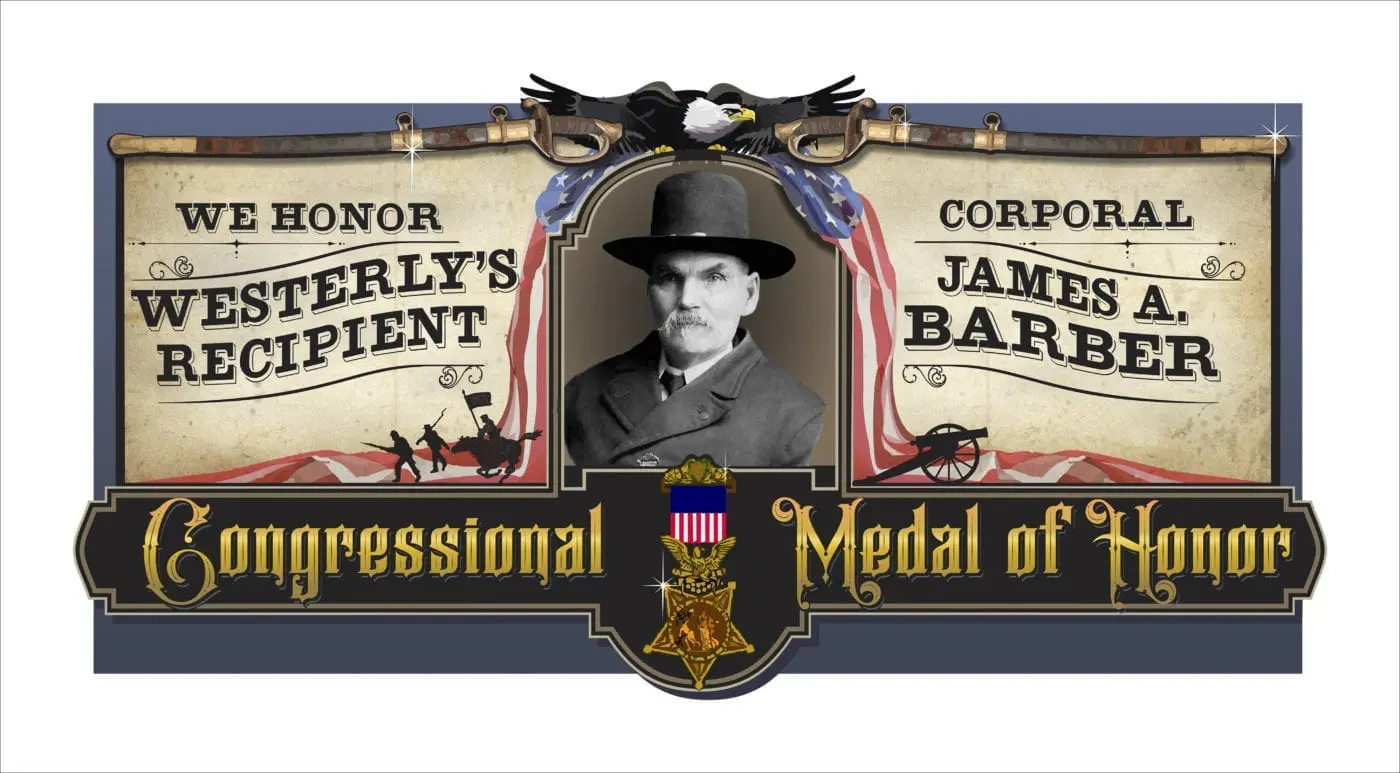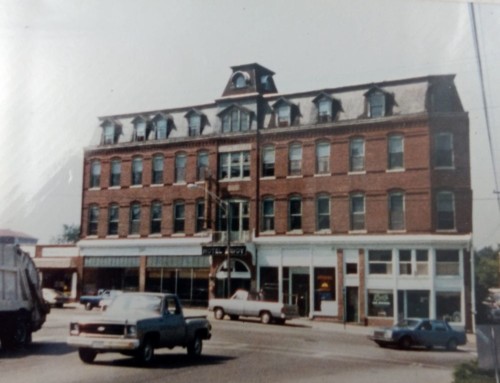In September, Westerly and Pawcatuck took part in Bricks and Murals, a two-community event showcasing the town’s history and culture. During the four-day festival, fifteen large murals were created. This is the first installment of our series about the history behind the murals, which will begin with the story of two prominent local Civil War veterans.
On April 2, 1865, twenty soldiers from the 1st Rhode Island Light Artillery Regiment, Company G voluntarily joined in an assaulting party against a troop of Confederate soldiers in Petersburg, Virginia. When all was said and done, the assaulting party had turned the enemy’s own guns on them, neutralizing the threat they posed.
Among those Rhode Island Artillerymen was Corporal James Albert Barber, a lifelong Westerly resident.[1] Barber’s bravery and valor in this mission did not go unnoticed, as he was awarded a Congressional Medal of Honor on June 16, 1866.[2] Barber’s legacy led to the creation of a mural in his honor, allowing his story to be forever preserved in the public consciousness.
James Albert Barber was born in Westerly on July 11, 1841 to Matthew Stillman Barber and his wife, Phoebe Elizabeth (Hall) Barber.[3] On November 11, 1861, at the age of 20, Barber enlisted in the army during the Civil War and he was assigned to the 1st Rhode Island Light Artillery Regiment, Company G.[4] He saw action at Yorktown, Antietam, Fredericksburg, and the second battle at Gettysburg.
During his service, Barber was twice wounded in action, once forcing him to spend two months in the hospital.[5] On June 24, 1865, after more than three years of service, Barber, now a Corporal, was mustered out and discharged from his battery.[6] He was presented with a Congressional Medal of Honor, the highest possible award for bravery given by the United States Government, as a result of his “gallant and meritorious conduct in action at Petersburg.”[7] After his discharge, Corporal Barber returned to Westerly, where he married his wife, Hannah J. Tourgee, on March 14, 1865. The couple had seven sons.[8]
Known locally as ‘ Captain Jim Barber,’ the Corporal spent his post-service life as a fisherman and at one time, served as the captain of the Watch Hill Life Saving Station. In his obituary, it was said that “he loved the sea and for years made his home on a sloop, the Triumph, anchored in Thompson’s Cove.”[9] In 1891, Barber was granted a pension for his service during the Civil War. He died in his home on East Avenue on June 26, 1925 and is buried in River Bend Cemetery, beneath a stone commemorating his service to his country.[10]
Although he is the only Medal of Honor winner born in Westerly, and the only one commemorated on the newly installed mural, Corp. Barber is not the only serviceman being buried in River Bend Cemetery.
Although he was born in Thompsonville, Sullivan, New York on November 4, 1843, David Johnson Naylor spent his post-Civil War life in Potter Hill (just across the town line in Hopkinton) and was buried in Westerly.[11]
On August 5, 1864, Naylor was serving as a Landsman for the Union Navy on-board the USS Oneida in Mobile Bay, Alabama. During a battle, Naylor, who was acting as powder boy at a 30-pound Parrott rifle, had his passing box shot out of his hands and knocked overboard. He then jumped overboard to recover the box and returned to his station where he continued his courageous acts, aiding the Union in capturing the Confederate ship Tennessee and damaging Fort Morgan, Alabama.[12] Naylor was issued his Medal of Honor on December 31, 1864.[13] He continued his service until he was discharged at the end of the war.[14]
After completing his service, David Johnson Naylor settled in southern Rhode Island, being accepted into Grace Church in Westerly on August 5, 1866.[15] On Valentine’s Day 1867, Naylor married his wife, Martha Thomas of Westerly.[16] That same year, he was initiated as a Mason in Franklin Lodge No. 20 in Westerly, and at the time of his death, he was the oldest surviving member of the lodge.[17]
In 1870, David, Martha, and their daughter, Sarah A. Naylor, were living in Stonington, where David had found work as a mill-hand.[18] The couple later welcomed two more children, Mark W. Naylor (named after David’s father,[19]) born in 1875 and Mattie E. Naylor, born in 1878.[20] By 1880, David J. Naylor and his family had moved to Potter Hill in Hopkinton, where he would live out the rest of his days, working in mills and as a school custodian.[21]
David Johnson Naylor succumbed to pneumonia in the early hours of February 7, 1926 at his home on Potter Hill. Naylor’s funeral is said to have had “a large attendance of relatives and friends and many floral tributes.”[22] He was interred in River Bend Cemetery among his family members.[23] According to his obituary, Naylor was “an esteemed resident of Potter Hill” who was awarded “a number of medals for bravery while he served in the U.S. Navy.”[24]
The courageous actions of both James Albert Barber and David Johnson Naylor during the American Civil War should never be forgotten. Now, due in large part to the recently-installed mural, their legacy will live on for generations to come, much like the acts of valor performed by the servicemen of Westerly who came after them and those who will continue to bravely defend America.
[su_accordion class=””] [su_spoiler title=”Footnotes” open=”no” style=”default” icon=”plus” anchor=”” class=””]
[1] “J.A. Barber Died This Morning” Westerly Sun, 26 June 1925.
[2] United States War Department, Medal of Honor Certificate, No. 36, James A. Barber, 19 May 1916.
[3] “J.A. Barber Died This Morning” Westerly Sun, 26 June 1925.
[4] “J.A. Barber Died This Morning” Westerly Sun, 26 June 1925.
[5] Westerly Sun, 26 July 1925, Transcript from the Collections of the Westerly Historical Society.
[6] United States War Department, Medal of Honor Certificate, No. 36, James A. Barber, 19 May 1916.
[7] “J.A. Barber Died This Morning” Westerly Sun, 26 June 1925.
[8] “J.A. Barber Died This Morning” Westerly Sun, 26 June 1925.
[9] “J.A. Barber Died This Morning” Westerly Sun, 26 June 1925.
[10] Return of a Death, State of Rhode Island, James Albert Barber, 26 June 1925.
[11] “Hero of Civil War is Dead” Westerly Sun, 7 February 1926.
[12] Congressional Medal of Honor Certificate, David Johnson Naylor.
[13] Congressional Medal of Honor Certificate, David Johnson Naylor.
[14] 1890 United States Veteran Census, Enumeration District No. 200, Line 5, David Johnson Naylor.
[15] Rhode Island, Vital Extracts, 1636-1899, vol. 11, pg. 193.
[16] Rhode Island, Vital Extracts, 1636-1899, vol. 11, pg. 33.
[17] “Funeral Service of Civil War Veteran” Westerly Sun, February 1926.
[18] Household of David Nayler, Stonington, New London, Connecticut, 1870 United States Census, Roll: M593_114; Page: 769B; Family History Library Film: 545613.
[19] Return of a Death, State of Rhode Island, David Johnson Naylor, 7 February 1926, Registered No. 220.
[20] Household of David Naylor, Hopkinton, Washington, Rhode Island, 1880 United States Census, Roll: 1210; Family History Film: 1255210; Page: 325A; Enumeration District: 154.
[21] Household of David Naylor, Hopkinton, Washington, Rhode Island, 1910 United States Census, Roll: T624_1445; Page: 18A; Enumeration District: 0301; FHL microfilm: 1375458 and David J. Naylor, Hopkinton, Washington, Rhode Island, 1915 Rhode Island State Census, District No. 430, Household 120.
[22] “Funeral Service of Civil War Veteran” Westerly Sun, February 1926.
[23] “Funeral Service of Civil War Veteran” Westerly Sun, February 1926.
[24] “Hero of Civil War is Dead” Westerly Sun, 7 February 1926.
[/su_spoiler] [/su_accordion]







